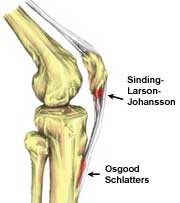Sinding-Larsen-Johansson (SLJ) syndrome is a painful overuse knee condition that commonly affects teenagers and involves the disruption of patellar tendon as it attaches to the inferior pole of the patella.
ANATOMY
The thigh bone (femur), shin bones (tibia and fibula), and knee cap (patella) form the knee joint which is the largest joint in the body. The quadriceps muscle attaches to the tibial tubercle through the patella via the thick patella tendon. Contraction of the quadriceps muscle on the front of the thigh straightens the knee. Actions that involve the quadriceps include kicking, walking up stairs, and landing from a jump.
Children and adolescents are skeletally immature and have special areas (growth plates) where the bones have not turned into strong and rigid but are still soft and cartilaginous. When skeletal maturity happens the whole bone is strong and rigid and there is no more cartilage. Every time the quadriceps muscles are used it pulls on the patellar tendon and the growth plate at the bottom of the knee cap.
PATHO-ANATOMY
People with SLJ usually have pain and swelling at the front of the knee near the bottom of the patella. The pain is often exacerbated by impact activities such as running, jumping, quick changes in direction, ascending/descending stairs. Squatting and kneeling can also cause pain. The pain is usually relieved by rest.
SLJ mostly occurs in boys between the ages of 10-15 who play sports that require a lot of running, jumping, impact on their legs because there activities place excess stress and strain on the knee. Examples of sports that place high stress are track and field, soccer, volleyball, gymnastics, basketball, lacrosse, and field hockey.
Risk may increase with overzealous exercise routines, large increases from normal exercise volumes, poor technique, muscle imbalances, being overweight, and poor physical condition (strength and flexibility)
SEQUALE
In SLJ syndrome complete recovery can be expected with closure of the patella growth plate and physiotherapy management. If not managed correctly SLJ syndrome can lead to functional limitations and pain for patients into adulthood. Uncommonly, SLJ syndrome may worsen to become an avulsion fracture where part of the patella separates from the rest of it.
INVESTIGATIONS
SLJ syndrome is normally diagnosed by your physiotherapist or doctor and does not require radiology. In very rare cases, you may be asked to get an x-ray or MRI to rule out other possible problems.
MANAGEMENT TYPES
Surgical intervention is very rare and treatment predominantly starts and ends with physiotherapy.
MEDICAL AND MEDICATION
Simple pain medications such as paracetamol and mild anti-inflammatories can be used with the guidance of your doctor. Cortisone injections are rarely, if ever, indicated.
PHYSIOTHERAPY
A physiotherapist will provide a further explanation of the specific aspects relating to the condition and will provide recommendations for managing the acute symptoms, rehabilitation, and return to physical activity. Initial treatment will consist of medication and ice to relieve pain. In most cases, modification to complete cessation of activities such as kneeling, jumping, squatting, stair climbing, and running will be recommended. Rehabilitation may involve: stretching tight muscles, strengthening exercises for the lower limb, movement retaining (such as running and walking), restricting specific sports participation and activity, bracing, orthotics, taping, and others. A patellar band (brace) may be an option recommended to you by your physiotherapist.

